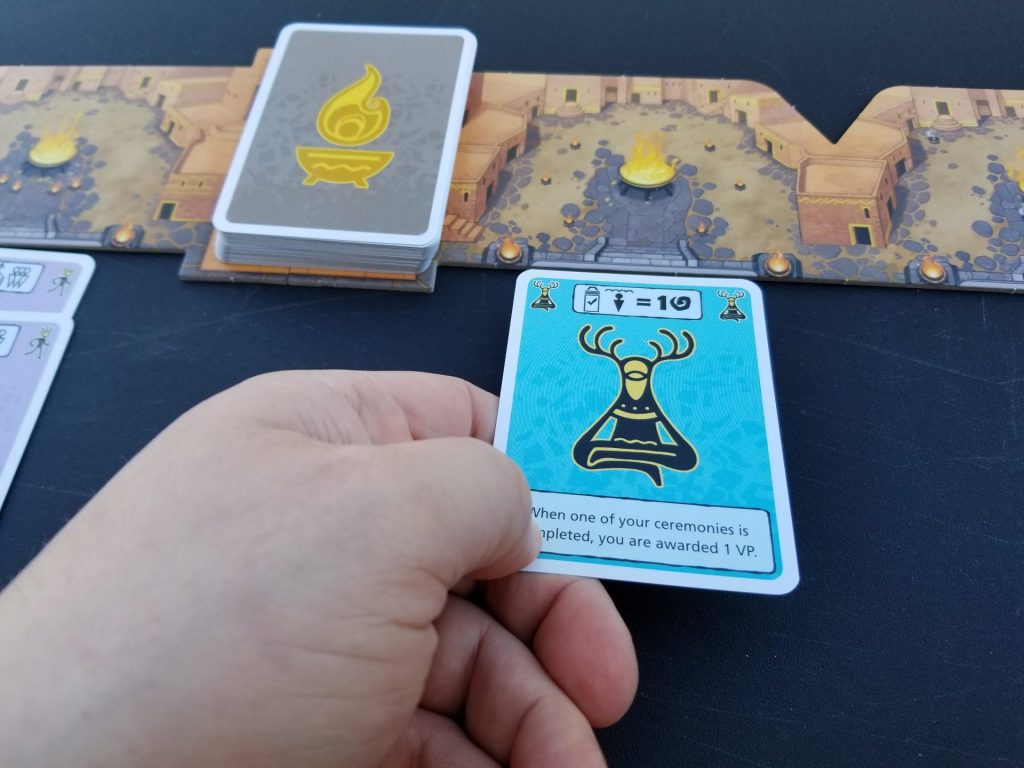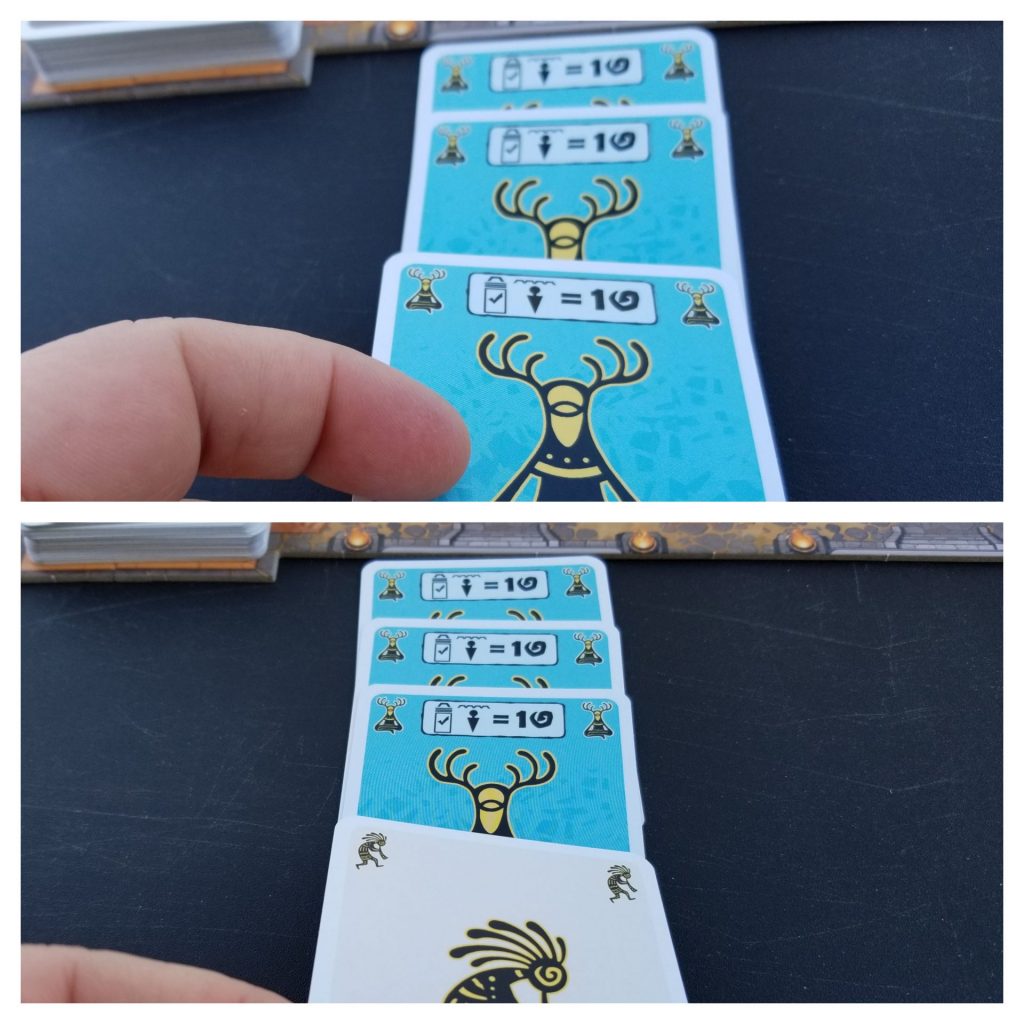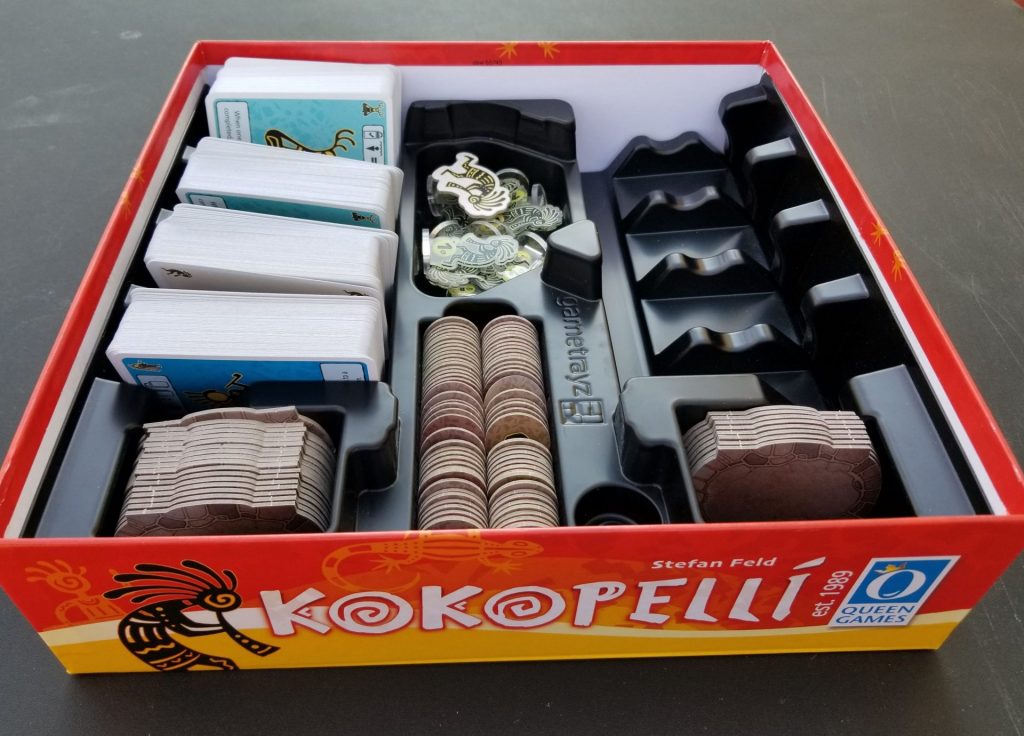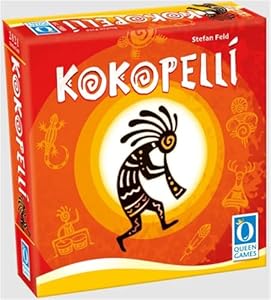Hello and welcome to ‘Focused on Feld’. In my Focused on Feld series of reviews, I am working my way through Stefan Feld’s entire catalogue. Over the years, I have hunted down and collected every title he has ever put out. Needless to say, I’m a fan of his work. I’m such a fan, in fact, that when I noticed there were no active Stefan Feld fan groups on Facebook, I created one of my own.
Today we’re going to talk about 2021’s Kokopelli, his 32nd game.
The titular Kokopelli is a fertility deity revered by some Native American cultures in the southwestern United States. Typically illustrated as a humpbacked figure playing a flute, Kokopelli was believed to have considerable influence over childbirth and agriculture. According to Wikipedia, Kokopelli uses his flute to chase away Winter to bring about Spring. He’s also possibly a representation of a Trader, many of whom used flutes to announce their arrival in a new village in a friendly way.
When it comes to the board game bearing his name, none of Kokopelli’s backstory is important. Story, as you will discover, is non-existent in this game. In fact, the rule book doesn’t even attempt to describe what’s going on, leaving the players to fill in the blanks provided by the context clues spread out like bread crumbs by the components and the game play.
Each player controls a village. In each village, players are competing to bring several ongoing ceremonies to completion in order to score points. So, presumably, the players are taking on the roles of chieftains trying to throw the best parties possible. True, the word “ceremony” makes these things sound like somber affairs, but I prefer to think of them as swinging parties: your villagers are taking to the streets in raucous celebration, voices raised in song, their excitement (about whatever the occasion) palpable and infectious. Indeed, with a story as thin (or non-existent) as the one the rule book provides, you just have to make up your own… and perhaps that’s the point: traditions, word-of-mouth, and storytelling around a campfire.
What is not up for debate or creative interpretation is how Kokopelli is actually played, so let’s delve into that, shall we? NOTE: if you’ve already got an idea of how to play the game and just want to know what I think, then feel free to skip ahead to the Thoughts section at the bottom of this review.
Party Planning
Inside the box of Kokopelli, aside from the absolute travesty of an insert, you will find 4 decks of cards with differently colored backs (1 deck per player). These card decks are composed of 48 Ceremony cards in 16 different styles (3 of each style) and 6 Kokopelli cards. The 16 different types of Ceremony cards correspond to the 16 Selection tiles also located in the box. During setup, 10 of these are randomly selected and the unselected ones are returned to the box. Then each player locates the cards matching the Selection tiles that were returned to the box and returns those to the box as well.
Aside from the thematic issue and the really bad insert mentioned previously, this fiddly setup (and consequential tear down) is my biggest gripe about this game. The rule book suggests turning the Selection tiles face down and shuffling them, but being tiles, they do not shuffle very easily. This is compounded even more if you add the expansion. I draw the tiles from a drawstring bag instead and it speeds up setup and tear down considerably. I wish something like this had been added instead of me having to provide my own. Kokopelli knows there’s enough room in the box for it.
There are also 4 Village boards (1 per player), 12 Game End tiles, and a bunch of Victory Point tiles with different values (1s, 3s, 4s, and 10s). The 10 Selection tiles are placed into the center of the table and seeded with Victory Point tiles thusly: each receives a 3 point tile and then a 4 point tile placed atop that one. The Game End tiles and the remaining Victory Point tiles are set off to the side in a general supply.

Each player receives a Village board in the same player color as their card backs. The cards they sorted earlier are shuffled into a deck and placed face down onto the center area of their Village board. Then a starting player is selected, given the first player marker, and you’re ready to begin.
Throwing A Shindig
The game is played over a variable number of rounds with each player going in turn clockwise around the table until one of the end game conditions is met. On a player’s turn, they will perform 2 actions from a list of 5 possible actions, repeating the same action twice if they decide to do so. Each action has a default result, but the action (and result) may be modified by cards that may be in play.
The first action is drawing a card. You simply draw a card from your draw pile and add it to your hand. Since you begin the game with no cards in hand, this will always be your first action of the game.
The second action is opening a ceremony. Place a card from your hand into an open ceremony spot on your player board. You have now opened a ceremony. You may never have duplicates of the same ceremony opened in your playing area.

The third action is playing a card. Cards may be played to any matching ceremonies on your player board or to one of the ceremonies in your neighbors’ public ceremony spaces (the ceremonies on either end of their player board). The second and third cards added to a ceremony will extend the ceremony. The fourth card played to a ceremony will finish it.

When a player finishes a ceremony, the player that owns the ceremony (i.e., it is in their playing area) will gather up the cards that comprise the ceremony and add them to their discard pile in any order. Then the player that completed the ceremony takes the visible Victory point tile from the top of the Selection tile that matches the ceremony that was just closed. If this removes the last Victory point tile from the Selection tile, then one of the Game End tiles is added to the Selection tile. Anyone that closes a matching ceremony in the future will receive a 1 value Victory point tile for their troubles. If the owner of the closed ceremony is not the active player, they will receive a 1 value Victory point tile.
The fourth action is cancelling a ceremony. Choose any ceremony in your playing area and add all of the cards from it to your face up discard pile in any order. While controlling the order that cards are added to your discard pile may seem arbitrary, there are cards that may come into play that will allow people to fish cards from other players’ discard piles.
The fifth action is exchanging cards. Take all of the cards in your hand and return them to the bottom of your draw pile in any order, then draw the same number of cards to replace them.
The most important thing to understand about Kokopelli is that you, and only you, are affected by the cards in the ceremonies in your playing area. Even though other players can try to play cards to them to finish them, they will never receive the benefits provided by your ceremonies unless those ceremonies say so. So, placement is important. For example, if you’ve got a couple of ceremonies in play that are garnering you a lot of points from their abilities and you want them to stay put for a while, then it behooves you to place them in the middle of your playing area.
It comes as no great shock to anyone familiar with Stefan Feld that Kokopelli is a game about scoring as many points as you can with points coming at you from every direction. Understanding where your points are coming from, how to maximize that point scoring potential, and protecting that engine is critical to doing well.
The Cleanup
The end game is triggered when the last Game End tile is placed onto the Selection tiles or when one player draws the last remaining card from their deck. Then the current round is finished such that every player has had an equal number of turns and final scoring occurs.
Players add all of the cards remaining in their hands to their draw piles and then count up the total number of cards remaining in those piles. The player with the fewest scores an extra 5 points and the player with the second most scores 3. Players score 1 point for each ceremony currently open in their playing areas. These are added to the points they scored over the course of the game and the player with the most points wins.
Thoughts
So, I’ve been reading through all of the Cormoran Strike mystery novels lately (an excellent series, by the way) and as I am reading these books I am keenly aware that they were penned by the same person that authored nearly everything ever written in the Harry Potter universe. Even though I know that Robert Galbraith is a pseudonym used by J.K. Rowling, it’s hard to believe that the same person that wrote The Silkworm, a novel which explores some of the most depraved things that human beings could ever do to one another, is none other than the author of the comparatively saccharine Harry Potter and the Sorcerer’s Stone. But if you look beyond the stories themselves and pay attention to the way that the words are written, their cadence, the vocabulary choices, you can hear Rowling’s voice clearly ringing through.
I know this is a strange way to begin a Thoughts section of a Stefan Feld game, but this is exactly the way that Kokopelli makes me feel. It is simultaneously like many of his other games, a victory point laden extravaganza, yet also so dissimilar that it almost feels like it isn’t a Stefan Feld game at all. Oddly enough, it makes me feel this way even more so than 2016’s The Oracle of Delphi which still stands as Feld’s one and only game that doesn’t rely on having the most points to win. I think maybe it’s because I’ve gotten used to Feld producing games more like Bonfire which comes in a box that is packed to the gills with components and has an intricate rules set that takes 15-20 minutes to teach to first time players. Kokopelli, on the other hand, can be taught in less than 5 minutes and has far fewer components. In fact, it could even be argued that there are components present in Kokopelli that aren’t even needed (like the Village boards, for instance).

But, like a three year old that looks tiny but feels like they have the density of a collapsing star when they trick you into picking them up, Kokopelli’s seeming lightness is belied by the interplay of the cards. And due to the random setup, each new play of the game will have you discovering interesting card interactions that you may not have encountered before. This is not to say that the card play in Kokopelli is as complex as a game like Magic: the Gathering, because it isn’t. Kokopelli is not a complex game. It’s a highly strategic one and that strategy is driven by the cards.
The first strategic decision you have to make, aside from choosing which action to perform, is where to open your ceremonies. Open them on the outside spots of your Village board and you risk your opponents adding to them and/or closing them. That’s not such a bad thing if none of the cards you have in play are synergizing well, but it becomes critical when you do. For instance, if you have Hunter which allows you to draw an extra card whenever you perform the ‘draw a card’ action and Birth which allows you to immediately play drawn cards to a ceremony (as opposed to having to spend another action to play the drawn card), then you may not want to give up the ability to possibly draw and play 6 cards (2 ‘draw a card’ actions) on a single turn. The best way to protect this synergy is by placing these 2 ceremonies on your inside spaces that cannot be added to by your opponents.
Another strategic decision that you have to make is figuring out which ceremonies to add cards to and how many. Add too many and there’s a chance your opponent might close the ceremony and get all the points for doing so. Hold out for too long, though, and your opponents may take that decision away from you by playing multiple cards of their own. The ideal situation is that you will always be the one closing out ceremonies, but reality is rarely, if ever, ideal. In Kokopelli, you’re going to have to outfox your opponents if you want to come out on top.
It’s a fun game, but definitely not one of Feld’s strongest efforts. My wife agrees. Having played Kokopelli several times now, she still isn’t a fan. But she’s not so opposed to it that she refuses to play it. It’s just not her go-to Feld game. And it isn’t mine either. I like Kokopelli, but I don’t love it. As an avid Feld collector, I am elated to have Kokopelli in my collection. But if I am being honest with myself, were it not for my Stefan Feld fixation, Kokopelli would be one of those games I’d be glad to play if someone else brought it out, but it wouldn’t be one that I’d be compelled to rush out and buy for my own.












Add Comment